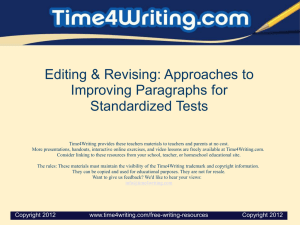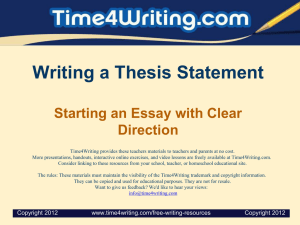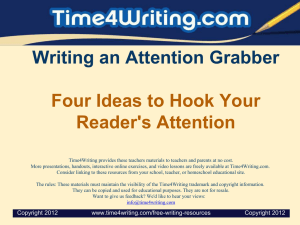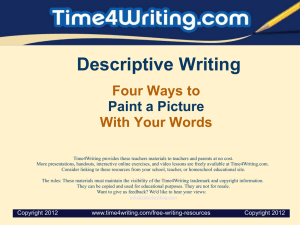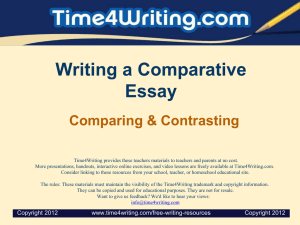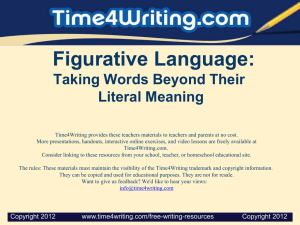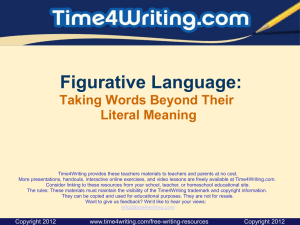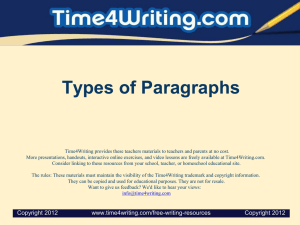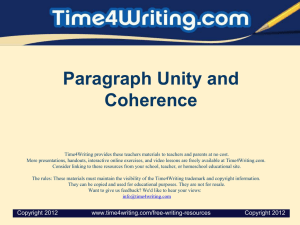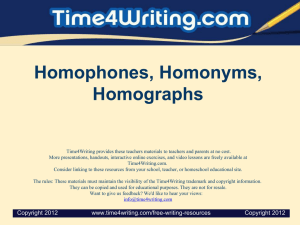Writing a Good Concluding Paragraph
advertisement
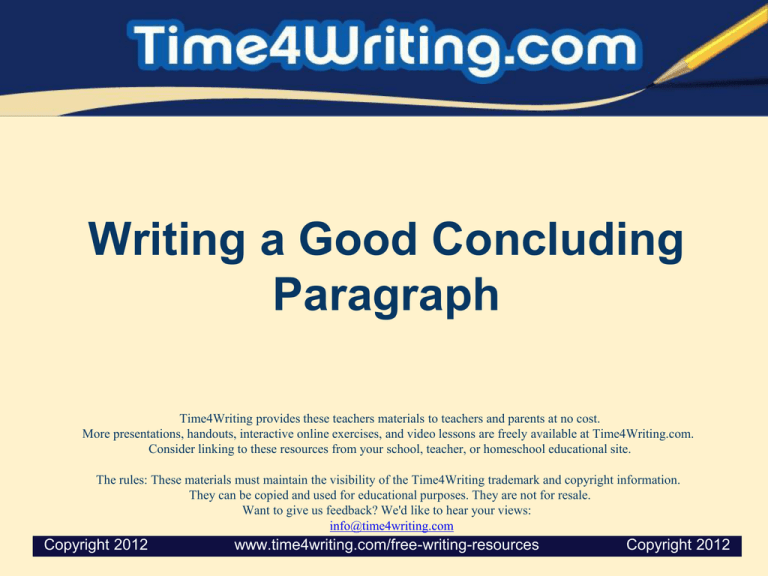
Writing a Good Concluding Paragraph Time4Writing provides these teachers materials to teachers and parents at no cost. More presentations, handouts, interactive online exercises, and video lessons are freely available at Time4Writing.com. Consider linking to these resources from your school, teacher, or homeschool educational site. The rules: These materials must maintain the visibility of the Time4Writing trademark and copyright information. They can be copied and used for educational purposes. They are not for resale. Want to give us feedback? We'd like to hear your views: info@time4writing.com Copyright 2012 www.time4writing.com/free-writing-resources Copyright 2012 What does the conclusion do? 1. it summarizes the essay 2. it shows you proved the point you set out to make 3. it gives the reader a sense of completion 4. it leaves the reader remembering your main point Copyright 2012 www.time4writing.com/free-writing-resources Copyright 2012 Wait, that sounds kind of like the introduction! So, what is the difference between the introductory paragraph & the concluding paragraph? The difference is in the approach to the topic. Copyright 2012 www.time4writing.com/free-writing-resources Copyright 2012 Think of these two paragraphs as funnels, one leading toward the body of your essay, while the other leads the reader away from the body. • The introduction begins with a general approach to the topic and then moves toward the more specific aspect(s) of it • The conclusion begins with the more specific aspect(s) and moves toward the general topic of your essay Copyright 2012 www.time4writing.com/free-writing-resources Copyright 2012 What main point did you want to make in your essay? •Did you make that point? •Summarize it in your conclusion. •Often you can use the introductory paragraph as a guide. This will hep you come full circle and give your reader a sense of completion. Copyright 2012 www.time4writing.com/free-writing-resources Copyright 2012 Perhaps you began your essay by saying: "There are three classes at school that I absolutely can’t wait to go to every day." Then you might make this the first sentence of your conclusion: "Gym, Math, and Art are the three classes I look forward to the most." Do you see how the first is more general and the last is more specific? Copyright 2012 www.time4writing.com/free-writing-resources Copyright 2012 Other Ways to Summarize the Essay's Main Points: • Refer briefly to the topic of each paragraph you wrote. • Leave readers with something to think about. • Suggest something readers can do about what they've just read. Copyright 2012 www.time4writing.com/free-writing-resources Copyright 2012 How to Structure the Final Paragraph 1. Topic sentence: repeat the ideas in your thesis statement, but with deeper understanding 2. Supporting sentences: summarize the main points in the body of your essay 3. Closing sentence: connect back to the introduction to "clinch" the ideas in the essay, showing their importance Copyright 2012 www.time4writing.com/free-writing-resources Copyright 2012 What if a new idea tries to sneak into that final paragraph? If it's really important, give it a paragraph of its own in the body of the essay. The concluding paragraph is not the place to introduce new information or make more points about the topic. Copyright 2012 www.time4writing.com/free-writing-resources Copyright 2012 The "So What?" Tip for Writing an Effective Conclusion After writing your topic sentence, ask yourself: "So what? Why is that important?" Your next sentence should explain why. Then ask yourself again: "So what? Why is that important?" And so on. Copyright 2012 www.time4writing.com/free-writing-resources Copyright 2012 Example of the "So What?" Method of Starting the Concluding Paragraph: "Education is very important in society." "So what? Why is it important?" "It gives all citizens an equal start." "So what? Why is that important?" Copyright 2012 Can you write an answer? www.time4writing.com/free-writing-resources Copyright 2012 Strategies for Ending the Concluding Paragraph: 1. Perhaps add a quotation or surprising insight from the materials you researched. 2. Suggest some action to take or a solution to an issue. 3. Bring up questions for further study. 4. Point out broader consequences of the points you've made. Copyright 2012 www.time4writing.com/free-writing-resources Copyright 2012 What NOT to Include in the Concluding Paragraph: 1. Overused phrases: "in conclusion," "in summary," "in closing" 2. A new idea or subtopic 3. Supporting evidence or details (these should be in the body of the essay) Copyright 2012 www.time4writing.com/free-writing-resources Copyright 2012 The end. More free ESSAY WRITING resources: the thesis statement the introduction comparing & contrasting types of essays (narrative, persuasive, comparative, expository) • • • • Eight-week ESSAY WRITING courses: elementary school middle school high school • • • Copyright 2012 www.time4writing.com/free-writing-resources Copyright 2012
